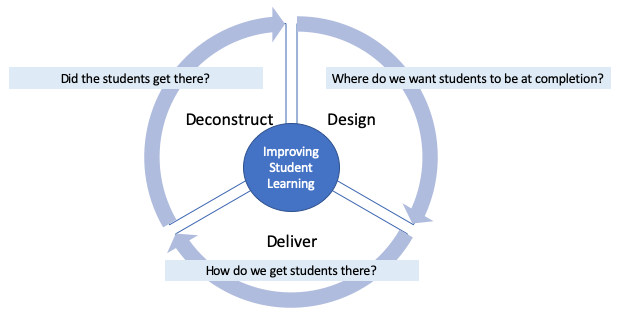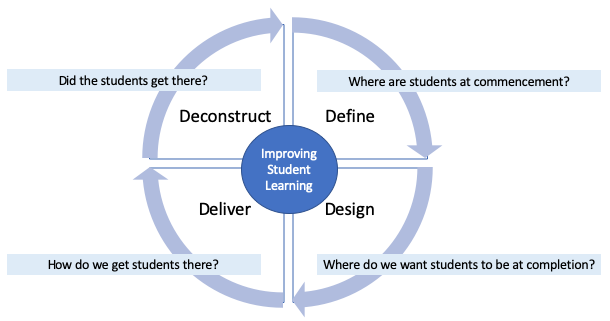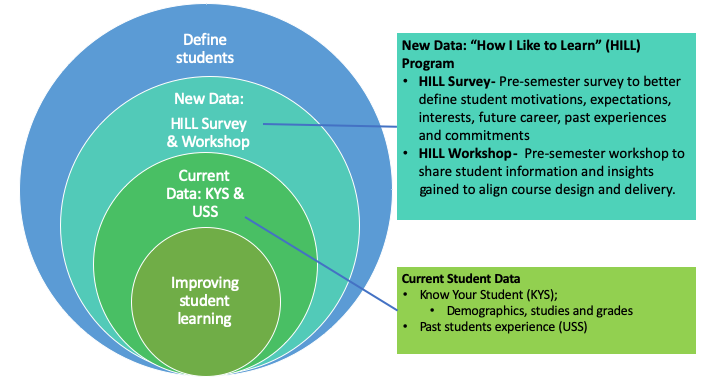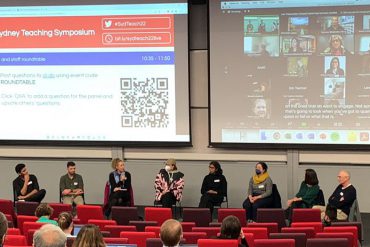As the year kicks off, there’s always the fascinating mix of excitement for a fresh semester, intermingled with the more mundane “recipe” of things we need to do to start the semester well. Creation of unit of study outlines, design of assessment tasks and unit schedules dominate educators’ minds, as if moving through this “checklist” will create the best student experience, or the best “Cake” for the semester. But does it?
This article was contributed by Robyn Martin, Richard Di Lernia and Kristian Kapetas.
Improving Teaching & Learning: the initial challenge
We are three teaching academics from the Sydney Business School, teaching large postgraduate units of study. At the beginning of 2019, we collaborated to evaluate our individual units of study and, based on these individual evaluations, challenge each other to focus on specific areas of our teaching and learning where we could improve student learning and experience.
A worthwhile and challenging task but one that left us, like many others, facing the age-old question: Where do we start? As educators, we are all aware of the multitude of “recipe steps” that can make or break a unit; creative unit design, engaging material and lectures/workshops, interesting and relevant tasks, improved feedback on assessments and more…the list can be long and varied. Although we were pleased overall with our USS results, we knew that all these areas could be “tightened up”. We needed a focus.
Through preliminary discussion with peers, students, and consequent literature investigations, it became apparent to us, that there is an informal ‘3 phase Teaching and Learning Lifecycle’ (Figure 1):
- Design (Where do we want students to be at completion?)
- Deliver (How do we get students there?)
- Deconstruct (Did the students get there?) i.e. evaluation of USS and grade success of unit cohort.

This approach seemed logical and practical and planted “Improving Student Learning” at the centre of the unit, but as each of us hurried off to look at various aspects of the lifecycle, we realised that this approach overlooks a fourth crucial phase.
How can we possibly understand “Did the students get there?” at the end of semester if we have little to no understanding of “Where are students at commencement?” You can’t track a journey if you aren’t clear of the starting point. It was as if we understood the “cooking method” but had no deep awareness of the “ingredients” before us. How can we place “improving student learning” at the center of our focus of our redesign approach without these crucial pieces of information? While we have access to previous semesters USS, this information is difficult to gain deep insights from, as it comes from a former student cohort who have experienced a unit which is often implemented by a different coordinator. We also have information in “Know your student” (KYS) but most of this is demographic and gives little insight into student motivations toward the unit or how they like to learn. Without an effective definition of our students, the improvements we make in design, delivery and deconstruction are being made in the dark. In light of this, it became crucial that we effectively understand the students before semester, prior to designing the unit. With this in mind, our fourth phase, “Define – Where are students at commencement?”, was realized in the Teaching and Learning Lifecycle (Figure 2).

Understanding the ingredients (or…who really are our students?)
So…how do we find out about who our students really are? We know:
- Prerequisites are completed;
- Unit of Study Survey (USS) feedback and insights; and
- Demographic information e.g. age and country of origin etc. through Knowing Your Students (KYS);
However, we had no idea as to why students have enrolled in our particular unit.
There are endless number of articles and publications that highlight the need to understand what drives students and motivates them to study. As academics, it is easy to mis-project our own interest in a topic or fascination in a subject area as the primary motivation for study. However, by placing ourselves firmly in the student’s shoes, we come to see that there is often quite a different point of view. Brookfield (2017) refers to this as observing through the student lens.
From this perspective, it became apparent that other important questions needed to be addressed in understanding student needs and catering for them in course design and delivery. These questions include;
- Are students interested in pursuing this discipline? Or was it just a degree requirement?
- Do they want to apply the learnings in a future career?
- Will that career be in corporate or do they want to be entrepreneurs, start in small business or work in a family business?
- Or is the choice of unit simply determined by their timetable and this selection means they only need to come to campus 2 days a week, allowing additional workdays? Or perhaps just extra time at the beach?
For the most part, we as teachers are in the dark when it comes to these motivations and the actual practicalities as to why students take our units.
Herein lay our challenge; we had no tool or structure to supplement the USS and KYS with an understanding of student motivations and how specific cohorts of students would like to learn. To solve this dilemma, we created the “How I Like to Learn” (HILL) Program.
A new approach – The “How I Like to Learn” (HILL) Program
The “How I Like to Learn” HILL program has two parts (see Figure 3):
- The HILL survey – an anonymous online pre-semester student questionnaire designed to understand students’ drivers/motivations and learning preferences for the unit. This questionnaire is designed to be short (15-20 mins) and able to be adapted for different disciplines.
- The HILL workshop – a pre-semester Educator workshop designed to draw unit educators together and share/implement the insights drawn from the survey. The HILL workshop ideally runs for around three hours and is held prior to the beginning of semester. This allows time to effect changes targeting, for example, specific design and delivery of the unit post-workshop if need be. Data from KYS, USS and HILL survey are shared among all unit teachers, facilitators, and select past and current student representatives to initiate teacher/student discussion, build on student insights, and ensure constructive alignment throughout the Teaching and Learning lifecycle.
This workshop would allow time for educators to consider the insights and address the following questions:
- How does this impact on our currently planned design and delivery?
- What types of learning experiences do students feel are optimal for them?
- How do we utilise the knowledge and experiences the students already have to encourage and support peer-to-peer learning and unit relevance?
With these two pre-semester components, The HILL Program facilitates unit design and delivery enhancements, bridges the gap between student and teacher perceptions, helps to uncover opportunities to support peer-to-peer learning within the learning environment, and improve subject relevance. Ultimately, the HILL program can provide educators with a deeper understanding of the “ingredients” in the classroom, improving their capacity to innovate, adapt and make targeted changes that, hopefully, improve student learning using a more directed and meaningful approach.

HILL in action – the pilot of the program
Robyn was able to pilot the HILL program semester 2 2019 in the unit MKTG5001 Marketing Principles, a foundation unit for the Postgraduate Master of Commerce.
Robyn’s experience with the MKTG5001 HILL Pilot
Faced with 620 students, an innovative teaching team of four, and the fact that it was my first time as MKTG5001 coordinator, I felt the pilot HILL program would allow me greater insight into my yet-to-have-met students. My KYS data showed that upwards of 90% of this unit were international students and so my goal was to understand what made these students tick when it came to how they liked to learn.
Refined HILL survey for Pilot
Beginning of semester being what it is, I choose to have a significantly contracted survey of only 6 questions (see table 1) and distributed these through Canvas, 2 weeks out from semester commencement. I also choose to have a relaxed and, hopefully, more informal manner to the survey to help alleviate any anxiety associated with limited understanding of new units/systems/university.
The first thing that was immediately interesting was that, despite the questionnaire being deployed two weeks before any formal classes began, as well as being online, anonymous and optional, there was a 60% response rate (372/620). This is in sharp contrast to the usual USS response rates which are much lower. It seems students are eager to talk about how they like to learn!
The questions and outcomes, insights and direct impact on teaching design and delivery, coming from the questionnaire are outlined below:
Table 1: HILL survey data from the pilot. You can use and adapt these questions when doing your own HILL survey!
| Questions and results
|
Insights drawn
|
Impact on Design & Delivery
|
Q1) I have enrolled in MKTG5001 because:
|
It was reassuring that most respondents were interested in the unit, although a significant proportion were there because they had to. | Ensure we highlight long term application opportunities for the material to hold engagement for interested students but be empathetic to the other students by openly sharing our experiences in completing units that we weren’t particularly interested in but were vital to the completion of our qualification. We’ve all been there. |
Q2) My past marketing experience is…….
|
With 40% of students identifying that they have fair or solid experience it is assumed that these students will be the ones who will more actively engage in discussions. But as 60% of the cohort have limited/minimal experience the more experienced, vocal students could make them feel isolated as they feel “I’m the only one who knows nothing”. | Ensure there are opportunities for full class and multiple small group peer-to peer discussions to allow students to share knowledge and also understand they aren’t the “only ones” supporting confidence to ask for assistance.
Also have exercises that revolve around discussing their own consumer experiences instead of just formal corporate examples. |
Q3) In the future I would like to work….
|
The pull to corporate is strong but not exclusive. | Traditionally we would use large multinational organisations for our case studies, but by understanding that there were many students who were interested in smaller businesses/entrepreneurship or hadn’t decided yet we embraced these smaller businesses in our case studies. |
Q4) The most valuable learning activities are….
Interactive activities – 17% |
Stepping away the “sage on the stage” and moving towards the “guide on the side” approach from the was the key insight here. | Ensure there was a solid mix of learning activities within the lecture. For example, use technologies such as Padlet , small group discussions, lecture as well as support preparation of material prior to class to optimise learning. The assessment activities were also kicked off with an individual learning exercise that was to be shared in small group discussions. |
| Q5) Things that help me learn (top mentions)
Case studies, corporate stories, applying knowledge in class, small group discussions, real life experiences, interactive content |
These insights supported our previous actions. | |
| Q6) Things that hinder my learning (top mentions)
Language/cultural barriers, time management (procrastination), difficult group members, masses of things to remember |
Have class activities that allow time for translators/ dictionaries/discussion etc. to clarify material and observe group interactions to also help support difficult group members. Communicate multiple small deadlines instead of just one end of semester one, shift the final exam to an open book exam to remove the pressure of having to “remember”. |
As we didn’t have a chance to gain the current student’s point of view within the HILL workshop (none were able to attend), I decided to share the HILL survey data at the first lecture, with surprising anecdotal results. When I shared this information, I was expecting little interest. However, much to the contrary, it seemed the shared experience of students feeling they are a little lost and overwhelmed struck a chord and started, even from the first lecture, to help the students build their confidence to share their own experiences within and outside of class.
Deconstruction and coming full circle
As the semester progressed, the MKTG5001 teaching team and I found ourselves regularly leaning back to HILL to either allay students concerns about their inexperience in the area or give creative direction to the week-by-week challenges we faced. Because of this, the teaching team felt that HILL was a solid approach to further augment the definition of “our students”. Coming back to our analogy, it helped us to better understand the “ingredients”, and not just the recipe and method being used.
Before the start of semester 1, 2020, I am running a deconstruction debrief session that will be attended by 2019 semester 2 and 2020 semester 1 teaching teams (i.e. past teaching team and future teaching team) and select students. This will help highlight areas of success and improvement as we move forward. Ultimately, I am hopeful we have baked something delicious! I am interested to see how the HILL program performed in this deconstruction, but I feel that by understanding our ingredients just a little more, the teaching team and I were able to bake a better cake for the semester and provide our students with a more connected and relevant learning experience. I am looking forward to moving this information back into the Teaching and Learning Lifecycle when I next am the coordinator.
What’s next?
If you are interested in baking something special with your students here are some tips and things to keep in mind:
- Student learning is not a recipe,
- Try not to use the recipe and a method alone without considering what you are cooking with,
- By understanding your ingredients to the best of your ability, you may find they surprise you and lead you in directions you had not even considered.
To find out more about the HILL program, please contact us at [email protected], [email protected] and [email protected]






1 Comment